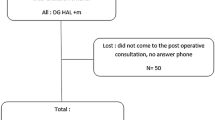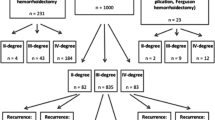Abstract
Purpose
Little is presently known on the impact of device type for Doppler-guided hemorrhoidal artery ligation/mucopexy (DGHAL) or circular stapled hemorrhoidopexy (CSH) when a surgical treatment is considered for hemorrhoidal disease (HD). In this study, we aimed to compare the outcome in terms of adverse events and recurrence rate, of patients included in the multicenter LigaLongo RCT (ClinicalTrials.gov NCT01240772) according to the type of devices used.
Methods
In the DGHAL arm (N = 193), the procedure was done with transanal hemorrhoidal dearterialization (THD)™ (THD, Correggio, Italy) (104 patients) and with HAL-RAR™ (Agency for Medical Innovations (AMI) GmbH, Feldkirch, Austria) (89 patients). In the CSH arm (N = 184), procedure for prolapse and hemorrhoids (PPH)-03™ (Ethicon Endo-Surgery, Cincinnati OH) and hemorrhoidopexy and prolapse (HEM)™ (Covidien, Inc.) staplers were used in respectively 106 and 78 cases. Surgery-related morbidity at 90 postoperative days (POD) based on the Clavien-Dindo procedure-related complication score and clinical outcome in terms of recurrence and reoperation rate at 12 postoperative months (POM) was collected.
Results
Three hundred and seventy-seven patients were randomized according to HD grade. In the DGHAL arm, the number of ligations and mucopexies was higher in the AMI group (p < 0.0001); at 90 POD, the overall morbidity was similar between the two groups. In the CSH arm, donut sizes were similar; at 90 POD, the PPH group had a higher risk of postoperative grade 1 morbidity (anal urgency or incontinence) compared to the HEM group (p = 0.003). At 12 POM, no statistical difference was found between the two groups of each arm in terms of grade III recurrence or reoperation.
Conclusion
Postoperative morbidity and outcome at 1 year were similar regardless of the type of devices used. These findings suggest that device type has little impact on HD treatment results.
Trial registration
clinicaltrials.gov—Identifier NCT01240772
Similar content being viewed by others
References
Brown S, Tiernan J, Biggs K, Hind D, Shephard N, Bradburn M, Wailoo A, Alshreef A, Swaby L, Watson A, Radley S, Jones O, Skaife P, Agarwal A, Giordano P, Lamah M, Cartmell M, Davies J, Faiz O, Nugent K, Clarke A, MacDonald A, Conaghan P, Ziprin P, Makhija R (2016) The HubBLe trial: haemorrhoidal artery ligation (HAL) versus rubber band ligation (RBL) for symptomatic second- and third-degree haemorrhoids: a multicentre randomised controlled trial and health-economic evaluation. Health Technol Assess Winch Engl 20:1–150
Watson AJM, Hudson J, Wood J, Kilonzo M, Brown SR, McDonald A, Norrie J, Bruhn H, Cook JA, eTHoS study group (2016) Comparison of stapled haemorrhoidopexy with traditional excisional surgery for haemorrhoidal disease (eTHoS): a pragmatic, multicentre, randomised controlled trial. Lancet 388:2375–2385
Lehur PA, Didnée AS, Faucheron J-L, Meurette G, Zerbib P, Siproudhis L, Vinson-Bonnet B, Dubois A, Casa C, Hardouin JB, Durand-Zaleski I, LigaLongo Study Group (2016) Cost-effectiveness of new surgical treatments for hemorrhoidal disease: a multicentre randomized controlled trial comparing transanal Doppler-guided hemorrhoidal artery ligation with mucopexy and circular stapled hemorrhoidopexy. Ann Surg 264:710–716
Gerjy R, Lindhoff-Larson A, Nyström P-O (2008) Grade of prolapse and symptoms of haemorrhoids are poorly correlated: result of a classification algorithm in 270 patients. Color Dis 10:694–700
Faucheron JL, Gangner Y (2008) Doppler-guided hemorrhoidal artery ligation for the treatment of symptomatic hemorrhoids: early and three-year follow-up results in 100 consecutive patients. Dis Colon Rectum 51:945–949
Gravié JF, Lehur PA, Huten N, Papillon M, Fantoli M, Descottes B, Pessaux P, Arnaud JP (2005) Stapled hemorrhoidopexy versus milligan-morgan hemorrhoidectomy: a prospective, randomized, multicenter trial with 2-year postoperative follow up. Ann Surg 242:29–35
Martin RCG, Brennan MF, Jaques DP (2002) Quality of complication reporting in the surgical literature. Ann Surg 235:803–813
Dindo D, Demartines N, Clavien P-A (2004) Classification of surgical complications: a new proposal with evaluation in a cohort of 6336 patients and results of a survey. Ann Surg 240:205–213
Hoyuela C, Carvajal F, Juvany M, Troyano D, Trias M, Martrat A, Ardid J, Obiols J (2016) HAL-RAR (Doppler guided haemorrhoid artery ligation with recto-anal repair) is a safe and effective procedure for haemorrhoids. Results of a prospective study after two-years follow-up. Int J Surg 28:39–44
Giuratrabocchetta S, Pecorella G, Stazi A, Tegon G, De Fazio M, Altomare DF (2013) Safety and short-term effectiveness of EEA stapler vs PPH stapler in the treatment of degree III haemorrhoids: prospective randomized controlled trial. Color Dis 15:354–358
Kahlke V, Bock JU, Peleikis HG, Jongen J (2011) Six years after: complications and long-term results after stapled hemorrhoidopexy with different devices. Langenbeck’s Arch Surg 396:659–667
Pérez-Vicente F, Arroyo A, Serrano P, Candela F, Sánchez A, Calpena R (2006) Prospective randomised clinical trial of single versus double purse-string stapled mucosectomy in the treatment of prolapsed haemorrhoids. Int J Color Dis 21:38–43
Zaheer S, Reilly WT, Pemberton JH, Ilstrup D (1998) Urinary retention after operations for benign anorectal diseases. Dis Colon Rectum 41:696–704
Qi-Ming X, Jue-Ying X, Ben-Hui C, Jing W, Ning L (2015) Risk factors for postoperative retention after hemorrhoidectomy: a cohort study. Gastroenterol Nurs 38:464–468
Acknowledgements
The authors are grateful to the “Direction de la recherche clinique,” University Hospital of Nantes: C Dert, V Wyart, C Kubis, and M Treuil-Peraldi for the data acquisition, maintenance of the database, support for data analysis, and layout of figures and J-B Hardouin, PhD (Unit of Methodology and Biostatistics, University Hospital of Nantes, Nantes, France) for the methodological support, statistical analysis, and interpretation. The Safety monitoring committee was led by Dr. L Abramowitz, MD, SNFCP study coordinator.
The authors also thank Andrew Spiers for the editorial review of the manuscript.
LigaLongo Study Group/Participating Investigators having provided and cared for study patients: J-P ARNAUD, C CASA (Service de chirurgie Viscérale, CHU Angers), M-L BARUSSAUD, M COMY (Service de chirurgie viscérale, CHD La Roche/Yon), F BORIE (Hôpital Caremeau, service de Chirurgie digestive, CHU Nîmes), C BOURBAO-TOURNOIS, N HUTEN (Service de chirurgie générale, Hôpital Trousseau, CHU Tours), PA LEHUR, G MEURETTE, H BOUTOILLE, J PODEVIN (Hôtel Dieu, CCDE, CHU Nantes), C BRIGAND, S ROHR (Hôpital de Hautepierre, Chirurgie générale et digestive, CHU Strasbourg), V DE PARADES, A SENEJOUX (Groupe hospitalier Paris Saint-Joseph), A DUBOIS (Service de chirurgie digestive, Hôpital de Vichy), M ELEOUET, F PIGOT (Service de proctologie, Hôpital Bagatelle, Talence), P FARTHOUAT (Polyclinique H. Malartic, Ollioules), J-L FAUCHERON, (Unité de Chirurgie Colorectale, CHU Grenoble), Y GANGNER, (Service de chirurgie digestive, CHD Niort), P GODEBERGE (Institut Mutualiste Montsouris, Paris), X LESAGE, Ph ZERBIB (Hôpital Claude Huriez, CHU Lille), P ORSONI (Service de chirurgie viscérale, AP-HM Hôpital Nord Marseille), R PALAGHIU, J PORCHERON (Service de chirurgie générale digestive, CHU Saint-Étienne), G PORTIER, M QUERALTO (Service de chirurgie digestive, Hôpital Purpan, CHU Toulouse), Y REDON (Service de Chirurgie Digestive, Pôle Hospitalier Mutualiste St Nazaire), I SIELEZNEFF (Service de chirurgie digestive et générale, La Timone, CHU Marseille), L SIPROUDHIS (SMAD, Pontchaillou, CHU Rennes), A-L TARRERIAS (Hôpital Foch, Paris), B VINSON-BONNET (Service de chirurgie viscérale, CH Poissy /Saint-Germain en Laye).
Contributions
Aurelien Venara: data collection, analysis, and interpretation. Manuscript author, provided a critical review of the manuscript and drafted the article. Final approval of the version to be published.
Juliette Podevin: provided care for study patients, provided a critical review of the manuscript, drafted the article, and revised it for important intellectual content. Final approval of the version to be published.
Philippe Godeberge: provided care for study patients, provided a critical review of the manuscript, drafted the article, and revised it for important intellectual content. Final approval of the version to be published.
Yann Redon: provided care for study patients, provided a critical review of the manuscript, drafted the article, and revised it for important intellectual content. Final approval of the version to be published.
Marie-Line Barussaud: provided care for study patients, provided a critical review of the manuscript, drafted the article, and revised it for important intellectual content. Final approval of the version to be published.
Igor Sielezneff: provided care for study patients, provided a critical review of the manuscript, drafted the article, and revised it for important intellectual content. Final approval of the version to be published.
Michel Queralto: provided care for study patients, provided a critical review of the manuscript, drafted the article, and revised it for important intellectual content. Final approval of the version to be published.
Celine Bourbao: provided care for study patients, provided a critical review of the manuscript, drafted the article, and revised it for important intellectual content. Final approval of the version to be published.
Anne Chiffoleau: Qualified Person Responsible for Pharmacovigilance (QPPV) in the trial. Provided a critical review of the manuscript. Final approval of the version to be published.
Paul A Lehur: conception, design, analysis and interpretation of data, manuscript author, provided a critical review of the manuscript, drafted the article, and revised it for important intellectual content. Final approval of the version to be published.
Sources of funding
This study was financed by a grant from the French Ministry of Health (PSTIC, 2010). The sponsor had no role in the study. The study was endorsed by the “Société Nationale Française de Colo-Proctologie” (SNFCP) and the “Société Française de Chirurgie Digestive” (SFCD). Direction Générale de l’Offre de Soins (DGOS)—Ministry of Health, France.
Author information
Authors and Affiliations
Consortia
Corresponding author
Ethics declarations
Conflict of interest
The authors declare that they have no conflict of interest.
Additional information
Podium presentation at the 2017 ASCRS—Tripartite meeting. Seattle (USA), June 2017.
Rights and permissions
About this article
Cite this article
Venara, A., Podevin, J., Godeberge, P. et al. A comparison of surgical devices for grade II and III hemorrhoidal disease. Results from the LigaLongo Trial comparing transanal Doppler-guided hemorrhoidal artery ligation with mucopexy and circular stapled hemorrhoidopexy. Int J Colorectal Dis 33, 1479–1483 (2018). https://doi.org/10.1007/s00384-018-3093-8
Accepted:
Published:
Issue Date:
DOI: https://doi.org/10.1007/s00384-018-3093-8




